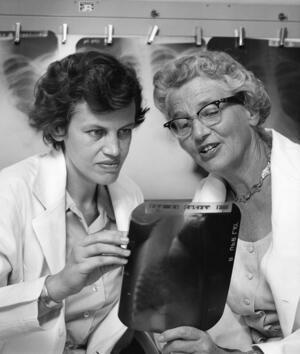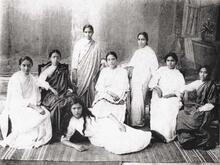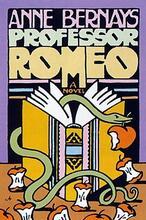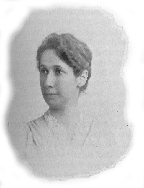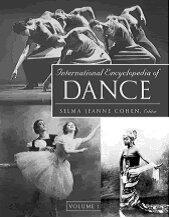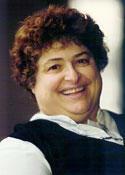Helen Brooke Taussig
Helen Brooke Taussig was one of the most celebrated physicians of the twentieth century. Starting in the 1920s, her early work focused on the clinical and anatomic manifestations of rheumatic fever. Later, in the mid-1940s, her ideas about the treatment of so-called blue babies led to the development of one of the first surgical procedures for treating infants with congenital cardiac defects. Through her research and teaching, she became a leader in the field of pediatric cardiology. Even after her retirement in 1963, she continued to publish medical articles, and at the time of her death at age eighty-seven she was actively engaged in research on the avian heart.
Helen Brooke Taussig was one of the most celebrated physicians of the twentieth century. Starting in the 1920s, her early work focused on the clinical and anatomic manifestations of rheumatic fever. Later, in the mid-1940s, her ideas about the treatment of so-called blue babies led to the development of one of the first surgical procedures for treating infants with congenital cardiac defects. Through her research and teaching, she was a leader in the development of the medical specialty of pediatric cardiology. In the 1960s, she was responsible for investigating the epidemic of serious congenital limb malformations in European children. She documented that the malformations were caused by the use of thalidomide by their mothers when pregnant. She continued to publish articles in the medical literature long after her 1963 retirement and, at the time of her death at age eighty-seven, was actively engaged in research on the avian heart.
Childhood and Education
Helen Brooke Taussig was born in Cambridge, Massachusetts, on May 24, 1898. On her father’s side she came from a distinguished St. Louis, Missouri, family. Taussig’s father, Frank William Taussig, held the Henry Lee chair in economics at Harvard University. Her mother, Edith Thomas Guild of Boston, had been a student at Radcliffe College and maintained an interest in zoology and other natural sciences. They had four children: William Guild, Mary Guild, Catherine Crombie, and Helen Brooke. Taussig’s mother died of tuberculosis when Taussig was eleven.
Suffering from lifelong dyslexia, Taussig was sometimes regarded by teachers as being retarded. Her father helped her learn to read, write, spell, and do numbers. Reading was never easy for Taussig, complicating any lengthy reviews of the literature for scientific articles. Taussig attended Radcliffe for two years before transferring to the University of California at Berkeley, where she graduated in 1921, Phi Beta Kappa. School policy prevented her from entering the then all-male Harvard Medical School. She was, however, allowed to study histology on a noncredit basis at Harvard, sitting in a remote corner of the hall during lectures and viewing slides in a separate room. It was at Boston University that Taussig became interested in the heart, having been encouraged to study the muscle bundles of the ox heart. In 1923, she matriculated at Johns Hopkins University School of Medicine, graduating in 1927 and maintaining her association with Hopkins for sixty years.
Following her graduation from medical school, she was appointed a fellow at the Heart Station at Hopkins and went on to develop the pediatric cardiology clinic there. At age thirty-one, she started to go deaf and by age thirty-five was using a hearing aid and an amplified stethoscope. She was able to compensate for the loss of her hearing through the use of her hands for palpation of patients’ chests. Otologic surgery in the 1960s substantially improved Taussig’s hearing.
Contributions to Medical Science
One of Taussig’s greatest contributions to medical science lay in the development, with surgeon Alfred Blalock, of the Blalock-Taussig procedure, a surgical technique that corrects cyanosis in certain types of congenital cardiac abnormalities. This operation launched the modern era of pediatric cardiac surgery. In her 1947 textbook Congenital Malformations of the Heart, Taussig made clear the results of her extensive anatomical and clinical work and provided a classic text for the developing fields of pediatric cardiology and pediatric cardiac surgery. She was one of only six physicians chosen by the American Board of Pediatrics to head the Sub-Board of Pediatric Cardiology, the official certifying body for the new subspecialty.
In 1962, following reports of an outbreak of serious congenital deformities in Europe, Taussig traveled throughout West Germany to investigate the situation. Concluding, as had German physicians, that the sedative thalidomide was responsible, Taussig authored an article in the Journal of the American Medical Association describing her findings. Her testimony before Congress and her scientific articles persuaded the Food and Drug Administration to disallow the sale of thalidomide in the United States.
Awards, Academia, and Legacy
Numerous honors came her way. Like her father before her, she was honored as a chevalier in the French Legion of Honor (1947). President Lyndon B. Johnson awarded her the Presidential Medal of Freedom (1964). Johns Hopkins, however, was not so generous. For the first sixteen years at Hopkins, she was an instructor; for the next thirteen, an associate professor. She held the rank of professor only for the four years preceding her 1963 retirement. She was, however, the first woman to hold a full professorship at the medical school.
Taussig never really retired. Of the more than one hundred scholarly articles she authored, she wrote approximately forty after retirement. At age sixty-seven, she became the first woman president of the American Heart Association. She remained active in her research until her death.
Taussig was not religious, although she described herself as Unitarian, as her mother had. She did not consider herself to be Jewish, although she told friends on occasion that she was of Jewish extraction on her father’s side.
Despite the many honors she received, her accomplishments as a physician and the respect she was accorded by her students and patients, Taussig’s life was complicated by serious adversity: her father’s mental illness during her childhood, her mother’s death, sex discrimination as she tried to educate herself, envy she experienced at her fame in the man’s world of medicine, insecurity about her Hopkins appointment, deafness, and dyslexia. She was a Democrat, pro-choice regarding abortion, and was a proponent of national health insurance.
Helen Brooke Taussig was killed in an automobile accident on May 21, 1986, three days shy of her eighty-eighth birthday.
Selected Works
Congenital Malformations of the Heart (1947. Revised 1960).
“Difficulties, Disappointments, and Delights in Medicine.” Pharos of Alpha Omega Alpha Honor Medical Society 42 (1979): 6–8.
“Little Choice and a Stimulating Environment.” Journal of the American Medical Women’s Association 36 (1981): 43–44.
“A Study of the German Outbreak of Phocomelia.” Journal of the American Medical Association 180 (1962): 1106–1114.
“The Surgical Treatment of Malformations of the Heart in Which There Is Pulmonary Stenosis or Pulmonary Atresia,” with Alfred Blalock. Journal of the American Medical Association 128 (1945): 189–202.
“At 67, Another First.” NYTimes, October 20, 1965, 31.
Burgess, Patricia, ed. “Helen Brooke Taussig.” In The Annual Obituary 1986 (1989).
Concise Dictionary of American Biography (1977), s.v. “Frank William Taussig” and “William Taussig”.
Current Biography Yearbook 1946, s.v. “Helen Brooke Taussig”.
Current Biography Yearbook 1966 (1966, 1967), s.v. “Helen Brooke Taussig”.
DAB (1935, 1936), s.v. “William Taussig”.
DAB (1958), s.v. “Frank William Taussig”.
Dietrich, Herbert J. “Helen Brooke Taussig, 1898–1986.” Transactions and Studies of the College of Physicians of Philadelphia 8, 4 (1986): 265–271.
“Dr. Taussig at 66.
As Busy as Ever.” NYTimes, December 20, 1964, 72.
Engle, Mary Allen. “Dr. Helen Brooke Taussig, Living Legend in Cardiology.” Clinical Cardiology 8, 6 (1985): 372–374.
“Helen Brooke Taussig, 87, Pioneer in the Field of Pediatric Cardiology.” Philadelphia Enquirer, May 22, 1986.
Henderson, Mary Taussig. “Mrs. Frank Taussig.” Radcliffe Memorial Biographies, vol. 4 (unpublished).
Hyde, William, and Howard L. Conard, eds. “Ethical Society of St. Louis.” In Encyclopedia of the History of St. Louis (1899).
McNamara, Dan G. “Helen Brooke Taussig: 1898–1986.” Pediatric Cardiology 7 (1986): 1–2.
McNamara, Dan G., et al. “Helen Brooke Taussig: 1898–1986.” Journal of the American College of Cardiology 10, 3 (1987): 662–671.
Neill, Catherine A. “Dr. Helen Brooke Taussig, May 24, 1898–May 21, 1986, International Cardiologist.” International Journal of Cardiology 14 (1987): 255–261.
“Noted Heart Doctor Killed in Crash.” Philadelphia Enquirer, May 21, 1986.
Ross, Richard S. “Presentation of the George M. Kober Medal (Posthumously) to Helen B. Taussig.” Transactions of the Association of American Physicians 100 (1987): cxii-cxxv.
Self-Culture Hall Association. 22d Annual Report (1910).

